|
|
||||
|
By Jo Nova Labor wants the poor to subsidize the rich EV car buyersGood news: The conservative opposition has promised to reduce the fines to zero for car manufacturers who sell “too many” diesel and petrol cars. This effectively negates the New Vehicle Emissions Standards (NVES), even though the Coalition says they will keep the standards (whatever that means). As standards were ratcheted up the fines could be as much as $25,000 on the largest utes and 4WDs. For a nation of petrol-heads, it’s amazing this diabolical policy hasn’t sparked outrage, probably only because it was buried in complexity. An honest government would have added a fee or a tax directly onto the kinds of cars they didn’t want sold — they could call it a pollution tax to cover the cost of the damage. The reason the Labor Government didn’t do that is because the unwashed masses would be revolting in the streets. So they make a rule that manufacturers have to sell a certain percentage of “good cars” that make future weather nicer (in theory), and then they can tell abject lies to the public like “it’s up to the car companies” and “manufacturers don’t have to pass the costs on” — as if any profit making entity can absorb fines of millions without raising prices. The sole point of the NVES was to punish petrol and diesel car buyers and subsidize EV manufacturers, and pretend the government was not doing the taxing and subsidizing because the money didn’t pass through any bureaucrats hands, even though the sole cause of the money flow was indeed the government. Election 2025: Liberals to drop fines on car emissionsBy Greg Brown, Sarah Elks, and Joanne Panagopoulis, The Australian The Coalition will abolish fines for car companies who breach targets under Australia’s first vehicle emissions standards scheme, in a major election commitment aimed at taking down the Albanese government’s claim that the price of petrol cars will not increase under Labor’s policy. The Australian can reveal the Coalition will retain the New Vehicle Emissions Standards, but will not punish companies financially that do not meet the tough carbon goals. Coalition sources said the policy, to be announced during the campaign, has the backing of the sector. Companies that miss the yearly target need to pay heavy fines or buy credits from suppliers that overperform, with industry modelling predicting car suppliers will be on the hook for $2.7bn of fines by the end of the decade. The effect of the pseudo car tax would be to limit sales of petrol and diesel cars by raising their prices, or taking them off the market, while reducing EV car prices — a policy that takes money from the poor in the outer suburbs and country areas in order to subsidize cars bought by inner city rich people. As petrol and diesel cars became more expensive, obviously their second hand price would increase as well. These people are professional liars:Chris Bowen (Energy Minister) implies the Labor policy has reduced the cost of EVs in Australia already (even before it started). Mr Bowen said. “When we came to office there were no models available under $45,000; now there’s eight. That is our policy starting to work with a lot more to do.” Somehow fines and penalties “increase the options” — as if stupid companies overseas were making cheap electric cars but forgot to send them to Australia: Jim Chalmers said the NVES was about introducing more options. “That will put downward pressure on prices over time,” the Treasurer said. Peter Dutton needs to find short one-liner ways to sell this policy because it’s a vote winner. The neutered NVES would be barely an aspirational fantasy goal without the fines. Presumably the opposition decided to keep it anyway just so the Labor Party couldn’t hit them easily with one-liners that “Liberals don’t care about pollution”. Where is our honest national conversation? Gone with the billion-dollar biased ABC, and government regulations that stop new competition arising in free-to-air media. In fact the NVES is purely about CO2 emissions, not about pollution. Carbon dioxide is an asset to a dry agricultural nation. The Coalition should axe the NVES entirely. Petrol and diesel drivers help feed the poor. In the UK, the same sort of rules were already in place, and due to the awful consequences on the car industry, even the untouchable Keir Starmer Government, years away from the next election, is already cutting fines by 20% and exempting British manufacturers like McLaren, Aston Martin and Bentley. Fines in the UK were as high as £15,000 per car, and set to get worse. The UK government has also added in all kinds of what they call “flexibilities” to keep the illusion that they are not back-tracking, while finding excuses to reduce the penalties. But of course, flexibilities are Soviet style complexities that means everyone needs more lawyers and accountants and more bureaucrats. It still feeds The Blob. It’s not the free market that brought the mass production of cheap cars to the unwashed masses in mere decades. Complexity helps the rich and punishes the poor, it just hides it better. The opposition should wage a war against these deceptive schemes. All the same outcomes could be achieved through honest simpler tax plans. Only liars and cheats want to dupe the voters with hidden subsidies that help the rich.
Think of Net Zero Targets as a self imposed Carbon TariffIf you just want cheap coal power, you can’t, not without paying the wind and solar tariff, the battery clause, the pumped hydro pill, and the interconnector addendum. Tonight the US Tariffs have been paused for 90 days (nearly everywhere bar China) while everyone negotiates, which was no doubt the plan all along, but the invisible Green Tariffs are so much worse. Instead of just being applied once at the border, they multiply like Ebola throughout the national economy — adding an invisible hit to anything that needs heating, cooling, feeding or moving — which is everything, sooner or later, and often many times. There’s no silver lining, no accidental benefit, we’re not changing the weather, we won’t make more crops, we’re not making cheaper electricity, and we’re not bringing factories back home, we’re shipping ours off to China (where they use coal). For every green job we artificially forced into existence we know the higher energy costs they lead to will destroy 2 – 5 real jobs. And we’re not even symbolically leading the world in some fashionable cat-walk, because no one is following. We could kid ourselves once that this Politburo style artificial quest might lead to new technologies the rest of the world wanted, but those days are over. The world doesn’t want EVs or solar “farms” much, it wants AI, and that means big and cheap energy. David Pearl in The Australian a few weeks ago (before the new round of tariffs were added): Net-zero black hole looms as self-inflicted tariff against the nation…our ever-rising electricity prices are a direct and entirely foreseeable result of the two major parties’ commitment to achieve net-zero carbon dioxide emissions. This policy is a self-imposed monster tariff on our entire $2.7 trillion economy, dwarfing Trump’s hit on our steel and aluminium sales to the US, which account for less than 0.2 per cent of our exports overall. And it is not a one-off shock, but a ratcheting up of energy costs that started more than a decade ago and must – if the share of wind and solar in our grid is to grow, as both major parties want – continue for the next quarter century. Not for one or two years, but for decades to come. It is deeply regressive, hurting low-income Australians more than those on higher incomes in exactly the same way an increase in the rate of the GST would. But unlike the GST, it delivers not a cent of revenue to government for hospitals and schools, but instead requires billions to be spent on subsidies each year for everyone harmed by it. So as the economy progressively weakens, the net-zero fiscal sinkhole must grow each year: a recipe for future financial collapse. David Pearl is a former Treasury assistant secretary.
By Jo Nova Trump switches on the giant dormant coal infrastructure of the USIn the last twenty years 770 coal turbines have been switched off in the US, and Donald Trump wants to turn as many back on as he can. Any moment now President Trump is expected to sign an executive order that will boost coal mining, keep old coal power stations running and restart shuttered coal plants. The word is that the US government will define coal as a “mineral” which allows him to use presidential wartime authority to speed up approvals for coal mines, and to bypass environmental red tape and even prioritize exploration and mining on federal lands. US agencies will be told to rescind any policies that aim to “transition away from coal” or “otherwise establish preferences against using fossil fuels”. The country with the largest known coal reserves in the world is now planning to increase coal exports. Furthermore Trump will ask the Energy Department to consider whether coal should be listed as a ‘critical mineral’ — something described as a ‘coveted status’ which activates even more emergency powers. Shares of coal companies in the US are up 11 to 18%, and the whole Australian obsession with closing our plants suddenly looks like a quaint book club garden party. While this will trigger the green brigade, they have nothing but the usual fantasies and wowser scoffing. [The Guardian] Energy experts say any bump for coal under Trump is likely to be temporary because natural gas is cheaper and there is a durable market for renewable energy such as wind and solar power no matter who holds the White House. Except there is barely any market for pure wind and solar power without truckloads of government subsidies. As soon as subsidies end, the solar panel companies go out of business. And of course, the intellectual titans hope pure scorn and mindless indignation will scare people away like little teenage girls: “What’s next, a mandate that Americans must commute by horse and buggy?” said Kit Kennedy, managing director of power at the Natural Resources Defense Council. This changes everythingAs this news breaks, Australia is 3.5 weeks away from an election. We have the third largest coal reserves in the world, and are often the world’s largest exporter of coal. Despite this, we treat coal like it’s kryptonite. It’s time to break this spell. The last week of tariff turmoil has been tough for the conservative opposition here in the shadow of teetering stock markets, but this could flip that effect the other way, if the Coalition can peg the Government as being irrationally anti-coal, pointlessly out of touch, and still fighting the last war while the real world steams on. This is the golden opportunity for Peter Dutton. This is the moment when Australia could run industrial AI datacenters on the cheapest coal power in the world. Our brown coal plants are still winning wholesale bids at less than 3 cents a kilowatt hour. We don’t have to be just a quarry where people do raindances to control the weather. Trump Order Seeks to Tap Coal Power in Quest to Dominate AIBy Ari Natter and Jennifer Dlouhy, Bloomberg President Donald Trump is moving to expand the mining and use of coal inside the US, a bid to power the boom in energy-hungry data centers and revive a flagging US fossil fuel industry. The steps including emphasizing the US is back in the business of selling coal mining rights on federal land and ordering the rock be designated as a critical mineral. Other actions include accelerating the export of US coal and related technologies. Nevertheless, the executive order underscores Trump’s commitment to tapping America’s coal resources as a source of both electricity to run data centers and heat to forge steel. The president and top administration officials have made clear boosting coal-fired power is a top priority, one they see as intertwined with national security and the US standing in a global competition to dominate the artificial intelligence industry. Coal advocates were cheering the planned action Tuesday. Trump wants to fix the electricity grid crisis: “Despite countless warnings from the nation’s grid operators and energy regulators that we are facing an electricity supply crisis, the last administration’s energy policies were built on hostility to fossil fuels, directly targeting coal,” said Rich Nolan, the president of the National Mining Association. “The explosive growth and parallel energy demands of artificial intelligence and electrification have rendered that path not just unsustainable but plainly reckless.” Mining.com lays out how big the coal industry used to be in the US. There is a massive skeleton of infrastructure Trump is working to revive: Coal accounts for about 15% of power generation in the US today, down from more than half in 2000, according to the US Energy Information Administration. Since 2000, about 770 individual coal-fired units have shuttered, according to data from Global Energy Monitor, with more set to close. No other major coal country is tying themselves into knots to keep the coal underground, or doing their best to stop using it. Australia is a basket case.
Today’s magic trick is how to make electricity look cheaper by taking money from childrenTomorrow — we pretend to control inflation by printing more money. The Labor Party tried to control the weather with our power stations and promised us it be would cheaper. For some reason that every engineer can explain, they damaged the electricity grid and electricity got more expensive. In order to hide this, they have to borrow money to pay us so they can pretend electricity is slightly less expensive, and inflation figures are not so scary. Since our children will pay off that debt one day somehow, the Labor Government is nicking the money from babies and telling us how compassionate they are.
More expensive than what Jim? The next magical $150 electricity rebate to households will cost $1.8 billion dollars. Think of it as a performance art, a piece of theatre, or a band-aid on a gaping wound. For Australians this will be the third year of rebates, so the total cost, respectively, is $3b in 2023 , plus $3.5b in 2024, plus $1.8b for a total of $8.3 billion. There’s no intellectual merit in the rebate, it’s not like it’s an incentive scheme for homeowners to “stay alive” or use more or less electricity. The sole point of the rebate is to hide the failure of the governments energy plan. It’s to bury the market signal which is screaming “bad, bad, bad” so the Labor Government can do more of the same “bad things” that got us into trouble in the first place. The PM also thinks giving away money reduces inflation:
We wonder why any country ever suffered inflation when the solution is so easy? $8 billion in Rebates could have made electricity cheaper for 30 yearsUnfortunately a “rebate” doesn’t reduce real electricity prices or inflation, except in advertising and ABC news (sorry, I repeat myself). If the government is going to incur a debt on our behalf, it could have used this $8 billion to buy at least four new gas plants and an advanced efficient coal plant, any or all of which would have reduced the price of electricity for 30 years to come (or 60 years in the case of a coal plant). For reference the cost of the 660MW Hunter Power Project is expected to be around $1b. China started building 92GW of coal plants last year, which is twice as much coal power as Australia has.
By Jo Nova In a brave election promise, the Australian Labor Party want poor people to help pay for batteries for rich Australians. The discount battery deals will only be suitable for people wealthy enough to own a home with solar panels, and who happen to have ten thousand dollars sitting around that they don’t want to use or expect any return on for nearly a decade. There can’t be too many of those. The true cost of home batteries is about $13,000, so the $4,000 discount still leaves a big bill. And the savings for electricity bills are estimated to be around $1,100 per household each year. So no one comes out ahead for nine or ten years, and that’s assuming their battery is still useful at age ten or eleven, and their house hasn’t caught fire. This policy isn’t a winner for the rich or the poor. Because batteries are essentially uneconomic, the policy screws the whole country. The only beneficiaries are the solar and battery installers and Chinese industrialists. Them, and the politicians who got us into this mess. To avoid admitting they were wrong, they’d probably like to trick Australians into buying the batteries that a renewables grid “has to have” but no one can afford. We only got into this mess because the government forced poor people to subsidize solar panel installations for rich people, and then hid it deep inside electricity bills. Ultimately this time too, the poor will end up paying — even though the wealthy pay the most tax, this scheme will be done on borrowed money, or buried in electricity bills. Throwing bad money after terrible moneyFor anyone connected to a large networked grid — the only possible benefit of a battery is to make surplus solar panels slightly less useless. Right now Australia is so overinstalled with solar panels that 1 in 3 homes has them, and the surge of power at lunchtime has become like a toxic waste. It threatens grid stability, costs money to dispose of, and forces large generators to switch off or operate inefficiently. Even large scale solar and wind power have to shut down. With four million rooftop panels, the situation is such a problem most states are demanding new panels have remote control switches, not so they can be turned on, but so they can be turned off. In Sydney, new charges are starting to apply to solar panel owners who dump their unneeded electricity on the grid. In the Northern Territory, they’re just leaving solar plants permanently disconnected, baking in the sun, to avoid the risk they’ll knock out Darwin’s grid, like they did in Alice Springs. The solar boom at noon distorts the market so wildly, it pushes reliable generators out of business, or forces them to raise their prices for the rest of the day, so they cover their costs. Industry chiefs admit investors don’t want to build many new generators anymore because of the midday glut. Go Labor Go, fight for those Green-Teal seatsThe Labor Party are fighting for the Green vote, but thankfully, the opposition are not. As long as conservatives keep pointing out the pain to the working class, and the unfairness of this, it will suck the moralistic fun out of buying a few Green voters. Next, if the conservatives could admit renewables are a dead-end, and weather control is a fantasy, they could start explaining why wind and solar power are guaranteed to make system wide electricity more expensive. Then they will really fire up the voters…
Corals around the world stopped growing in 2000BC and the pause lasted two thousand years before they returned like the Phoenix.Each polyp might be fragile, but coral ecosystems are the couch-grass of the oceans. A new paper rather puts the man-made panic about corals into perspective. The most terrible events that could happen to corals have already happened, and the corals appear able to bide their time for two thousand years and return in all their glory. The worst thing for the worlds corals is not rising seas but falling ones. We panic over the odd bit of bleaching here and there, but it’s nothing compared to mother nature. The shallow edges of the oceans of the world are savage places. And the best place to study this mayhem is the Red Sea. Not only is it hot, but long, thin, deep, and it’s tectonically active too. In the depths of the last ice age, it was cut off from the Indian Ocean and the salinity rose to a death defying 47% at the Southern end, and 57% in the north. For thousands of years, the Red Sea was pickled. When the world finally warmed and waters came back 18,000 years ago, baby corals had to travel 2,400 kilometers from the Gulf of Aden to get to Eilat, at the far northern end of the Red Sea, yet they easily did. And the seas kept on rising for thousand of years, and that was all fine and dandy, until disaster struck 4,000 years ago when the seas started to fall, and presumably those delicate polyps were left to bake in the sun. Feldman et al, studied this phenomenon in the Red Sea and noticed that other scientists have already reported coral growth stagnated in all the major oceans at roughly the same time. For two thousand years there are almost no new fossil corals in any of the cores they drilled. Then somehow, the distinct coral communities that had thrived long before, all reappeared. Imagine if seas were falling by a few millimeters a year today? The government funded scientists would be raging against the falling of the tide. Whole institutes would be established to move corals to baby nurseries, or special zoos, or to set up seed banks, or to wall off whole reefs. People would be dreaming up schemes to heat the oceans… But like couch-grass, we couldn’t kill the corals off in the oceans if we wanted to.Thanks to Kenneth Richard at NoTricksZone for finding this paper: In this study, we propose not just a local sea level condition causing specific reef turn-offs or hiatuses, but rather a global phenomenon of sea level fall. In light of our findings from Eilat and examining the reports from different locations around the globe (discussed above), we identify a global hiatus in reef growth between approximately 4000 and 2300 years BP (Figure 5). The available studies found almost no fossil corals dated to this time interval at sites across the Atlantic, Indian, and Pacific Oceans (Cortes et al. 1994; Dechnik et al. 2019; Gischler et al. 2008; Perry and Smithers 2011; Shaked et al. 2004, 2005, 2011; Toth et al. 2012), 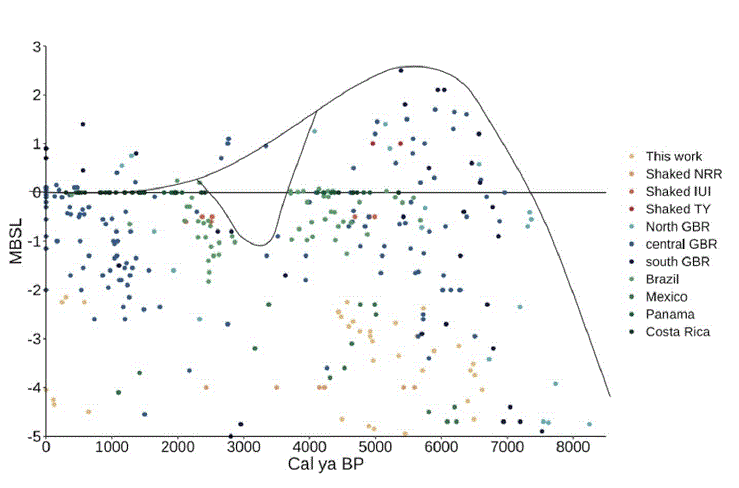 FIGURE 5 | Reconstruction of global sea level—Compilation of radiocarbon dates from seven sites vs. mean below sea level (MBSL). Possible global sea level curve is presented with demonstrated fall between ~4000–2300 years BP. Reading the paper is like trawling through an epic biblical drama. Corals want to grow near the surface to harvest the sunlight, so as the seas rise, they just grow upward. When seas stabilize they spread outwards. But the Red Sea has steep sides and the corals can’t expand far. The reef they studied at Eilat at the far northern end, was 1 kilometer long, but only 20m wide. Then just when those delicate corals get settled, a tectonic upheaval blows it away.  (d) Pictures of all seven cores extracted from the lagoon, reef flat and fore reef of the Nature Reserve in Eilat, and some of the coral species that have been found (e) A sketch of Eilat’s Nature Reserve coral reef with all seven extracted cores and their locations. Black arrows on core’s sides represent if were taken from the north (up) or south (down) jetty. So Feldman et al drill all these cores, and find all the remnants of different species, but when they date the samples they discover there is a kind of Bermuda triangle there in the history of corals. All corals below a certain depth are 4400 years or older, and just above that they are 700 years old. For thousands of years on this reef, the corals were effectively dead. At some point the corals must have been baked in the sun, and a millennia or two later, they have been reseeded. Perhaps a few remnants struggled on somewhere nearby, or maybe they come from a thousand miles away. But somehow they still came back. The whole ecosystem just resumes where it left off. 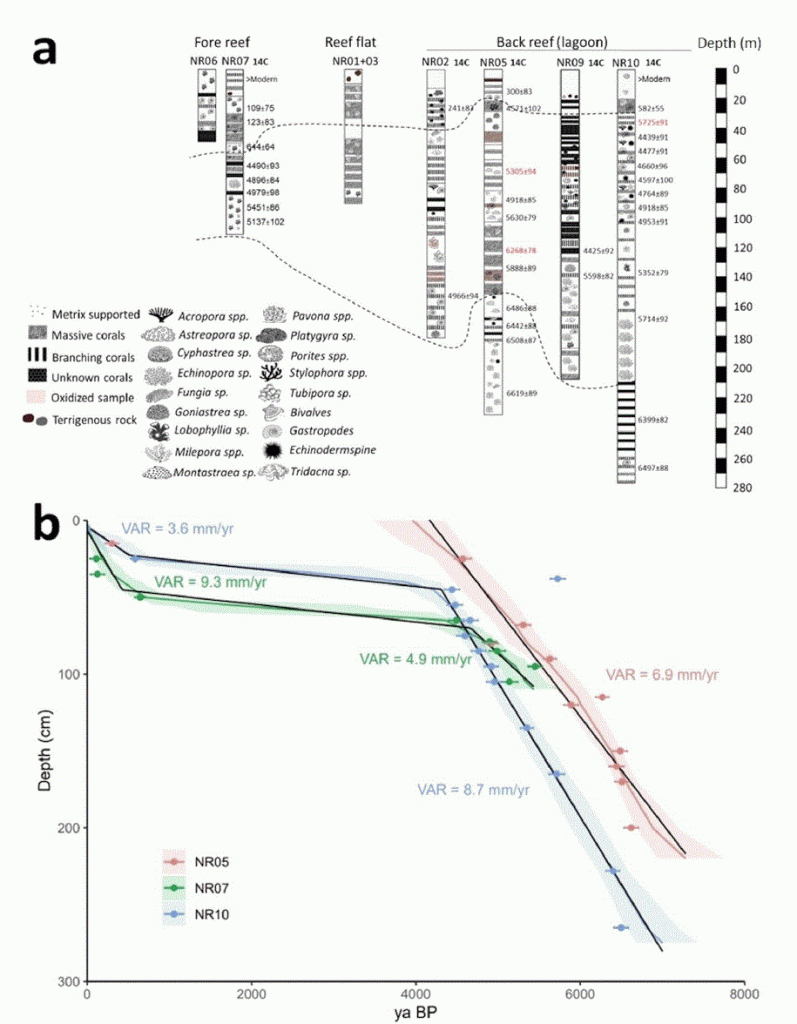 FIGURE 2 | (a) Core lithology and coarse coral community structure of all seven cores from the Nature Reserve Eilat. 14C dates (calibrates year BP) as well as U-Th dates are presented at the right side of each core. Dates in red represent age reversals. The upper dashed line separate between recent samples and 4000 yr. dated samples. The middle part separates the 4000 yr. dates and the 5000 yr. samples. Everything beneath the lower line is 6000 yr. and older. (b) Age depth model for cores NR05, NR07 and NR10. Measured ages are marked by colored symbols and error bars (dR = −8 and uncertainty = 33). The model is the black line with error in matching color. Accordingly, the hiatus spans between ~4400 y cal BP and ~ 700 y cal BP. Spare a thought for all those poor little polyps when the next real crisis comes and we get another Ice Age. Spare a thought for us, too… REFERENCEFeldman B, Torfstein A, O’Leary M, Blecher NS, Yam R, Shaked Y, Shemesh A, Huang D, Levy O. (2025) Late Holocene “Turn-Off” of Coral Reef Growth in the Northern Red Sea and Implications for a Sea-Level Fall. Glob Chang Biol. 2025 Feb;31(2):e70073. doi: 10.1111/gcb.70073. PMID: 39936330; PMCID: PMC11815541.
By Jo Nova Forget the carbon credits and solar panels, the root cause of climate change is Caribbean slavery.
This new (old) rehash of White Guilt is so dark, we wonder why the author, Tao Leigh Goffe, chooses to live in the evil empire of the capitalist US. Shouldn’t she boycott it, and move to a place that never had slavery, like Antarctica? For a woman who claims the world is boiling today because of of the dark inhuman laboratory of experiments, it does seem incongruous that she supports the same institutions that grew from ..as she puts it …Columbus’s travesty. She decries European scientific colonialism and a “scientific method rooted in eugenics and racism”, yet she probably wrote her book on a computer with silicon chips, and works at City University, New York, surely an institutional product of that same ghastly colonialism? She got her PhD at Yale. Is there no moral limit to her hypocrisy? Wait til she finds out the theory of climate change, which her career depends on, mutated out of the same scientific method which she says is rooted in racism and denigrates black and indigenous forms of science? I mean, which is it? Somehow white science is nonsense, but climate change is real? If ever we needed a reason to stop funding academia, to just say “No”, this study would be it. The hypocrisy, the self-contradictory internally inconsistent, attention seeking and incoherent non-research, pretty much encapsulate everything that is unworthy in academia. And we can get more of the same for free from any AI, except it would make more sense. Her book “Dark Laboratory” is one of the few books that may have already crossed the too-bad-to-be-AI line. And where are all those climate scientist champions of science, now?Here’s an anti-science academic seeking fame and glory while trashing science. So where are you, O Defenders of University consensuses and experts? This woman is damaging all of academia — and they won’t even stand up and tell her that slavery doesn’t correlate well with Global Warming. All parts of The Blob defend the rest of The Blob. Climate science is just another part of the same anti-Western, collectivist, parasitic Blob. Dark Laboratory: groundbreaking book argues climate crisis was sparked by colonisationTao Leigh Goffe argues climate breakdown is the mutant offspring of European scientific racism and colonialism But Tao Leigh Goffe, an associate professor of Africana, Puerto Rican and Latino Studies at the City University of New York, wants us to visualise a far more specific cause: the shunting of a ship’s prow on to the sandbank of a paradise island in 1492. In Dark Laboratory, her groundbreaking new book, Goffe argues that it was the colonization of the Americas by Christopher Columbus that set off the chain of events that has led us to where we stand today, on the precipice of global catastrophe. Historians and scientists will be surprised to hear that capitalism, monocrop agriculture, and land clearing was invented in Jamaica… It was there [in the Carribbean] that enslaving farmers first formulated the structures of modern capitalism, alongside a scientific method rooted in eugenics and racism that privileged the status of white men while denigrating Black and Indigenous forms of science. Such experiments included the creation of monocrop agriculture, the clearing of terrestrial and marine ecosystems making territories vulnerable to extreme weather, the categorisation of wildlife along lines of superficial characteristics and the now equally discredited categorisation of different races along similar lines. We must, she argues, “connect the dots between the brutal system of chattel slavery and the degradation of the natural environment … The worlds Europeans built depended on making the lives of some disposable.” Perhaps we should connect the dots between narcissistic academics and the tax slaves forced to fund them today? Call it modern slavery. The lives of the working class serfs who fund Tao Leigh Goffe seem pretty disposable to her. At least they didn’t waste money on the book cover. Her X feed: @taoleightgoffe Image: Columbus Taking Possession, Wikimedia. By Jo Nova All that stuff about a 1 in 100 year flood, they have no ideaIt turns out the worst flood on the Rhine was not in 2024 but in 1374. On the Severn, in England the worst year for “climate change” was 250 BC. Obviously neither of them were due to man-made oil and gas. A thousand news headlines have said modern floods were unprecedented, or were 1 in 1000 year events, or were caused by “climate change” and they were all based on just 120 years of data (or less), and they were all wrong. For some reason, even though climate change is the most important thing on Earth, hardly any researchers were looking for evidence of long term extreme flood events. When researchers finally studied the sediments left at many sites — they found evidence that many ancient floods were just as bad or even worse. At least 12 times, ancient peak river flows were bigger than anything we’ve seen in the instrumental record. (And they’re just the ancient floods we know about, imagine if we put more scientists looking into fluvial sediments?). The only thing unprecedented about modern floods is the gall of scientists who ignore the last 8,000 years. They say that Storm Blah was 8.3 times more likely, and enhanced 42% by beefsteaks and Renaults. But all those attribution calculations assume that they know what “normal” flooding is. If floods were worse 1,000, 2,000 or 4,000 years ago, nature is sometimes much meaner and nastier than most of us know. We could be hit with something terrible and be caught unprepared. But likewise, if we think these latest floods were due to coal-fired power plants, we might squander a civilization trying to stop floods with electrical Voodoo, which apparently we are. Climate change is NOT the main cause of floods – and those today are ‘nowhere near’ the most extreme— Daily Mail Study author Professor Stephan Harrison at the University of Exeter said recent floods are not exceptional if we look further into the past. ‘In recent years, floods around the world – including in Pakistan, Spain and Germany – have killed thousands of people and caused enormous damage,’ he said. ‘Such floods are seen as “unprecedented” – but if you look back over the last few thousand years, that’s not the case. ‘In fact, floods we call unprecedented may be nowhere near the most extreme that have happened in the past.’ It’s definitely not a hockeystickIn the worst flood of the Upper Severn river around 250BC, fifty percent more water was flowing at the peak, than in the floods of the year 2000AD. The more important question is why we spent so many trillions on pointless weather controlling talismans instead of hiring a few scientists to look at paleoclimate data. We could have saved so much money and suffering, and ended so much grift and graft. Harrison et al looked at found that most of the worst floods were in the warmest era’s — like the Holocene optimum and the Roman warming times — which is what we’d expect. Warmer times evaporate more water off the oceans and into the sky. But the worst flood was in 1374 and was due to snow and ice melting, proving that no climate is perfect, and we really need to learn to predict it. Harrison et al say the climate modelers of attribution and detection studies were wrong. And that this it is “the first time” anyone has put all these longer studies together. But all those sediments were there in 2010, just like they were there in 1990, but no one was studying them. That’s a scandal. REFERENCE Harrison, S., Macklin, M.G., Toonen, W.H.J. et al. Robust climate attribution of modern floods needs palaeoflood science. Climatic Change 178, 71 (2025). https://doi.org/10.1007/s10584-025-03904-9
|
||||
|
Copyright © 2025 JoNova - All Rights Reserved |
||||


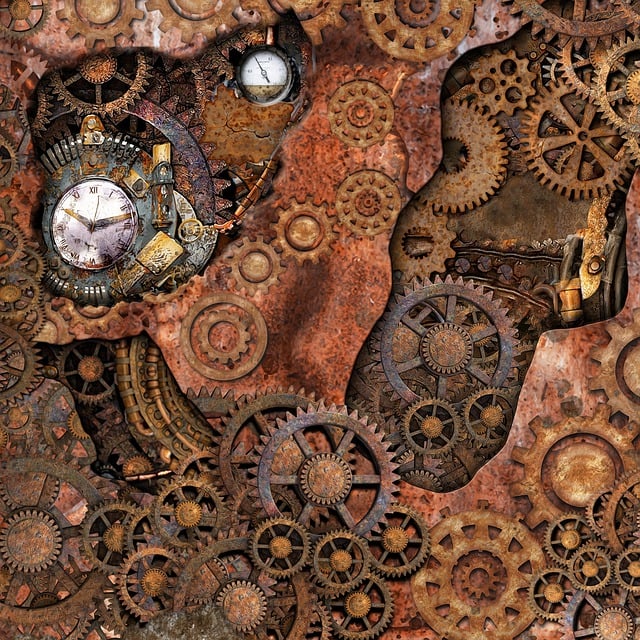
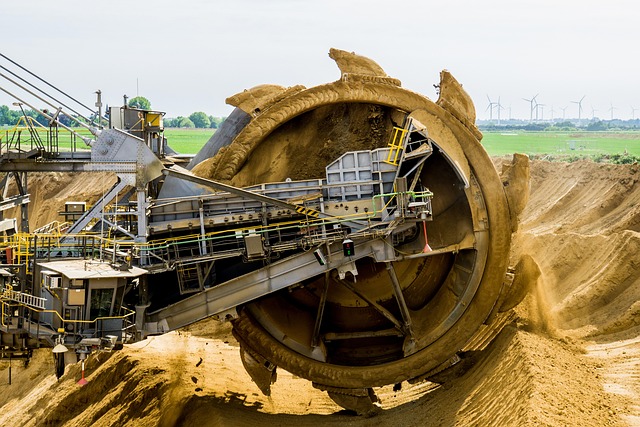
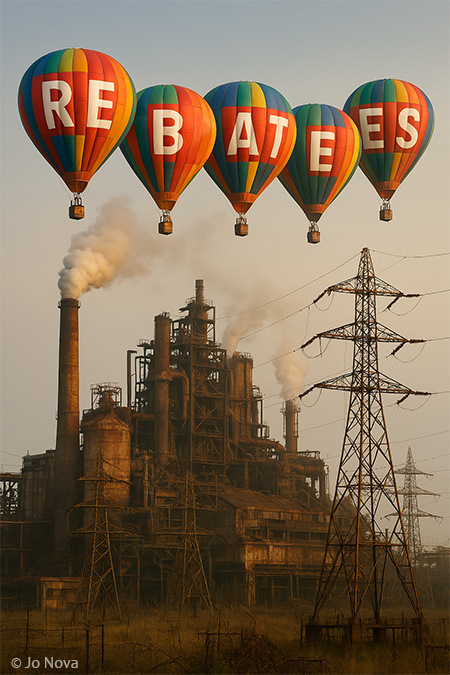

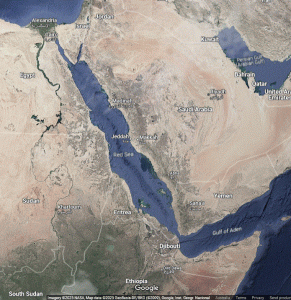

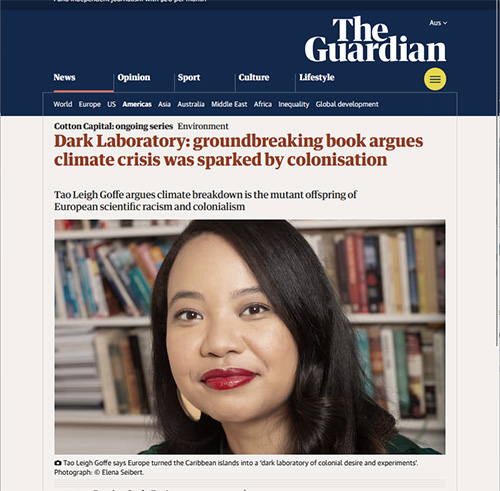
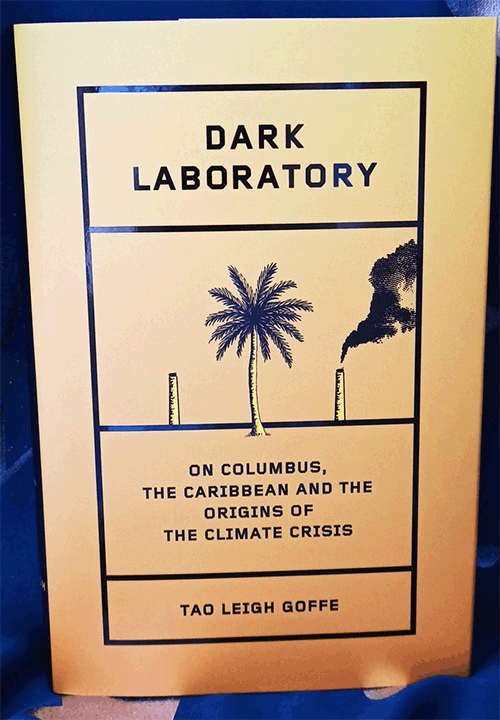
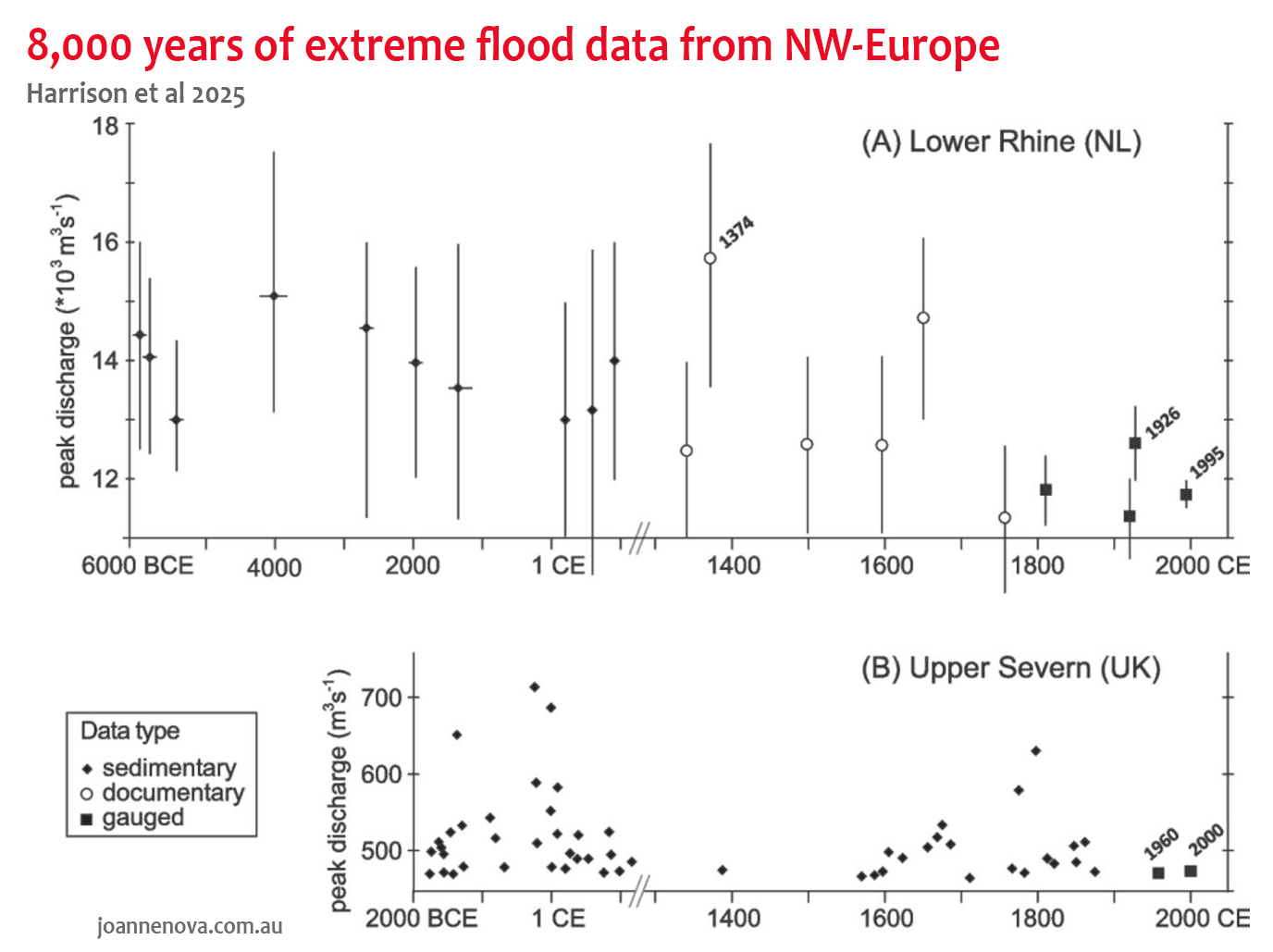
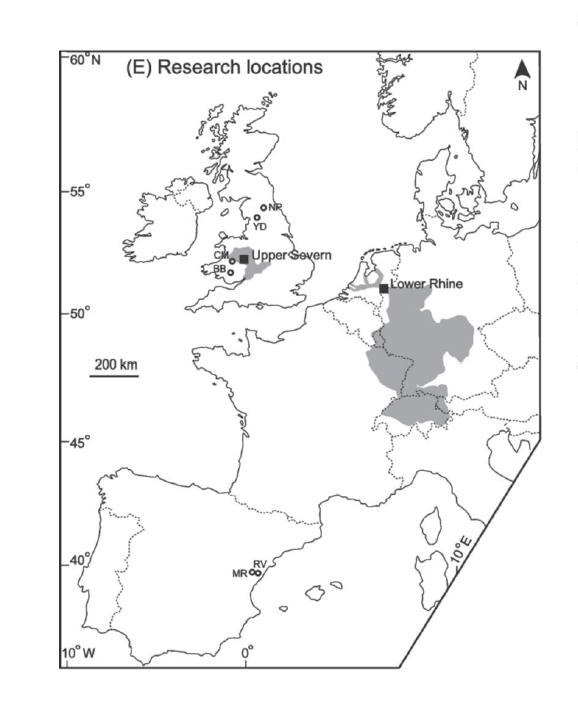
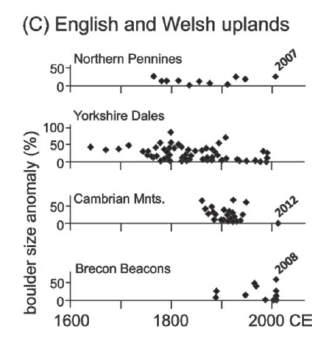











Recent Comments